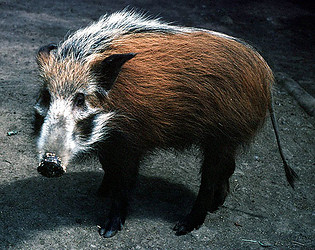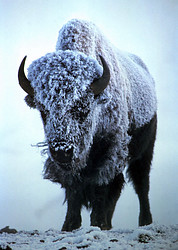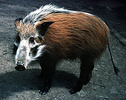Artiodactyla
Even-toed ungulates



This tree diagram shows the relationships between several groups of organisms.
The root of the current tree connects the organisms featured in this tree to their containing group and the rest of the Tree of Life. The basal branching point in the tree represents the ancestor of the other groups in the tree. This ancestor diversified over time into several descendent subgroups, which are represented as internal nodes and terminal taxa to the right.

You can click on the root to travel down the Tree of Life all the way to the root of all Life, and you can click on the names of descendent subgroups to travel up the Tree of Life all the way to individual species.
For more information on ToL tree formatting, please see Interpreting the Tree or Classification. To learn more about phylogenetic trees, please visit our Phylogenetic Biology pages.
close boxReferences
Adachi, J. and M. Hasegawa. 1996. Instability of quartet analyses of molecular sequence data by the maximum likelihood method: The Cetacea/Artiodactyla relationships. Molecular Phylogenetics and Evolution 6:72-76.
Agnarsson, I. and L. J. May-Collado. 2008. The phylogeny of Cetartiodactyla: The importance of dense taxon sampling, missing data, and the remarkable promise of cytochrome b to provide reliable species-level phylogenies. Molecular Phylogenetics and Evolution 48(3):964-985.
Boisserie, J. R., F. Lihoreau, and M. Brunet. 2005. The position of hippopotamidae within cetartiodactyla. Proceedings of the National Academy of Sciences (USA) 102(5):1537-1541.
Buntjer, J. B., I. A. Hoff, and J. A. Lenstra. 1997. Artiodactyl interspersed DNA repeats in cetacean genomes. Journal of Molecular Evolution 45:66-69.
Carroll, R.L. 1988. Vertebrate Paleontology and Evolution. W.H. Freeman and Company, New York.
Douzery, E. and F. M. Catzeflis. 1995. Molecular evolution of the mitochondrial 12S ribosomal RNA in Ungulata (Mammalia). Journal of Molecular Evolution 41:622-636.
Gatesy, J. 1997. More DNA support for a Cetacea/Hippopotamidae clade: the blood-clotting protein gene gamma-fibrinogen. Molecular Biology and Evolution 14:537-543.
Gatesy, J., C. Hayashi, M. A. Cronin, and P. Arctander. 1996. Evidence from milk casein genes that cetaceans are close relatives of hippopotamid artiodactyls. Molecular Biology and Evolution 13:954-963.
Gatesy, J., M. Milinkovitch, V. Waddell, and M. Stanhope. 1999. Stability of cladistic relationships between Cetacea and higher-level Artiodactyl taxa. Systematic Biology 48:6-20.
Gatesy, J., P. O'Grady, and R. H. Baker. 1999. Corroboration among data sets in simultaneous analysis: Hidden support for phylogenetic relationships among higher level artiodactyl taxa. Cladistics 15:271-313.
Geisler, J. H. 2001. New morphological evidence for the phylogeny of Artiodactyla, Cetacea, and Mesonychidae. American Museum Novitates 3344: 1-53.
Gentry, A. W. and J. J. Hooker. 1988. The phylogeny of the Artiodactyla. Pages 235-272 in The Phylogeny and Classification of the Tetrapods, Volume 2. Mammals. M. J. P. Benton, ed. Clarendon Press, Oxford.
Gingerich, P. D., M. ulHaq, I. S. Zalmout, I. H. Khan, and M. S Malkani. 2001. Origin of whales from early artiodactyls: hands and feet of Eocene Protocetidae from Pakistan. Science 293:2239-2242.
Graur, D. and D. G. Higgins. 1994. Molecular evidence for the inclusion of cetaceans within the order Artiodactyla. Molecular Biology and Evolution 11:357-364.
Grubb, P. 1993. Order Artiodactyla. Pages 377-414 in Mammal Species of the World D. E. Wilson and D. M. Reeder, eds. Smithsonian Institution Press, Washington.
Hasegawa, M. and J. Adachi. 1996. Phylogenetic position of Cetaceans relative to Artiodactyls: Reanalysis of mitochondrial and nuclear sequences. Molecular Biology and Evolution 13:710-717.
Janis, C. M. 1982. Evolution of horns in ungulates: ecology and paleoecology. Biological Reviews 57:261-318.
Janis, C. M. 1995. Correlation between craniodental morphology and feeding behavior in ungulates: Reciprocal illumination between living and fossil taxa. Pages 76-98 in: Functional Morphology in Vertebrate Paleontology. G. J. Thomason, ed. Cambridge University Press, Cambridge.
Janis, C. M., J. A. Effinger, J. A. Harrison, J. G. Honey, D. G. Kron, B. Lander, E. Manning, D. R. Prothero, M. S. Stevens, R. K. Stucky, S. D. Webb, and D. B. Wright. 1998. Artiodactyla. Pages 337-357 in Evolution of Tertiary Mammals of North Americ. C. M. Janis, K. M. Scott and L. L. Jacobs, eds. Cambridge University Press, Cambridge.
Kingdon, J. 1997. The Kingdon Field Guide to African Mammals. Academic Press, London.
Kleineidam, R. G., G. Pesole, H. J. Breukelman, J. J. Beintema, R. A. Kastelein. 1999. Inclusion of cetaceans within the order Artiodactyla based on phylogenetic analysis of pancreatic ribonuclease genes. Journal of Molecular Evolution 48:360-368.
Klungland, H., K. H. Roed, C. L. Nesbo, K. S. Jakobsen, and D. I. Vage. 1999. The melanocyte-stimulating hormone receptor (MC1-R) gene as a tool in evolutionary studies of Artiodactyles. Hereditas 131:39-46.
Kostia, S., M. Ruohonen-Lehto, R. Vainola, and S.-L. Varvio. 2000. Phylogenetic information in inter-SINE and interSSR fingerprints of the Artiodactyla and evolution of the Bov-tA SINE. Heredity 84:37-45.
Langer, P. 2001. Evidence from the digestive tract on phylogenetic relationships in ungulates and whales. Journal of Zoology, Systematics, Evolution and Research 39:77-90.
Lin, C. S., Y. L. Sun, C. Y. Liu, P. C. Yang, L. C. Chang, I. C. Cheng, S J. T. Mao, and M. C. Huang. 1999. Complete nucleotide sequence of pig (Sus scrofa) mitochondrial genome and dating evolutionary divergence within Artiodactyla. Gene 236:107-114.
Luo, Z.-X. 2000. In search of the whales' sisters. Nature 404:235-239.
Mahon, A. 2004. A molecular supertree of the Artiodactyla. Pages 411-437 in Phylogenetic Supertrees: Combining Information to Reveal the Tree of Life. O. R. P. Bininda-Emonds), ed. Kluwer Academic Publishers, Dordrecht.
Matthee, C. A., J. D. Burzlaff, J. F. Taylor, and S. K. Davis. 2001. Mining the mammalian genome for artiodactyl systematics. Systematic Biology 50:367-390.
McKenna, M. C. and S. K. Bell. 1997. Classification of Mammals Above the Species Level. Columbia University Press, New York.
Miyamoto, M. M., F. Kraus, P. J. Laipis, S. M. Tanhauser, and S. D. Webb. 1993. Mitochondrial DNA phylogenies within Artiodactyla. Pages 268-281 in Mammal Phylogeny. Volume 2. Placentals. (F. S. Szalay, M. J. Novacek, and M. C. McKenna, eds.) Springer Verlag, New York.
Modi, W. S., D. S. Gallagher, and J. E. Womack. 1996. Evolutionary histories of highly repeated DNA families among the artiodactyla (mammalia). Journal of Molecular Evolution 42:337-349.
Montgelard, C., F. M. Catzeflis, and E. Douzery. 1997. Phylogenetic relationships of artiodactyls and cetaceans as deduced from the comparison of cytochrome b and 12S rRNA mitochondrial sequences. Molecular Biology and Evolution 14:550-559.
Montgelard, C., S. Ducrocq, and E. Douzery. 1998. What is a Suiforme (Artiodactyla)? Contribution of cranioskeletal and mitochondrial DNA data. Molecular Phylogenetics and Evolution 9:528-532.
Naylor, G. J. P. and D. C. Adams. 2001. Are the fossil data really at odds with the molecular data? Morphological evidence for Cetartiodactyla phylogeny reexamined. Systematic Biology, 50:444-453.
Nikaido, M., A. P. Rooney, and N. Okada. 1999. Phylogenetic relationships among cetartiodactyls based on insertions of short and long interpersed elements: Hippopotamuses are the closest extant relatives of whales. Proceedings of the National Academy of Sciences (USA) 96:10261-10266.
Nowak, R.M. 1999. Order Artiodactyla. Pages 1051-1238 in: Walker's Mammals of the World. Sixth Edition. Volume II. (R. M. Nowak). Johns Hopkins University Press, Baltimore.
O'Leary, M. A. 1999. Parsimony analysis of total evidence from extinct and extant taxa and the Cetacean-Artiodactyl question (Mammalia, Ungulata). Cladistics 15:315-330.
O'Leary, M. A. and J. H. Geisler. 1999. The position of cetacea within mammalia: Phylogenetic analysis of morphological data from extinct and extant taxa. Systematic Biology 48:455-490.
Oliver, W. L. R. 1995. Taxonomy and conservation status of the suiformes - an overview. Ibex 3:3-5.
Pérez-Barbería, F. J. and I. J. Gordon. 1999. The functional relationship between feeding type and jaw and cranial morphology in ungulates. Oecologia 118:157-165.
Pérez-Barbería, F. J. and I. J. Gordon. 2000. Differences in body mass and oral morphology between the sexes in the Artiodactyla: evolutionary relationships with sexual segregation. Evolutionary Ecology Research 2:667-684.
Pérez-Barbería, F. J., I. J. Gordon, and C. Nores. 2001. Evolutionary transitions among feeding styles and habitats in ungulates. Evolutionary Ecology Research 3:221-230.
Price, S. A., O. R. P. Bininda-Emonds, and J. L. Gittleman. 2005. A complete phylogeny of the whales, dolphins and even-toed hoofed mammals (Cetartiodactyla). Biological Reviews 80(3):445 - 473.
Prothero, D. R. and R. M. Schoch. 2002. Horns, Tusks, and Flippers: the Evolution of Hoofed Mammals. Johns Hopkins University Press.
Randi, E., V. Lucchini, and C. H. Diong. 1996. Evolutionary genetics of the suiformes as reconstructed using mtDNA sequencing. Journal of Mammalian Evolution 3:163-194.
Rose, K. D. 1996. On the origin of the order Artiodactyla. Proceedings of the National Academy of Sciences (USA) 93:1705-1709.
Shedlock, A. M., M. C. Milinkovitch, and N. Okada. 2000. SINE evolution, missing data, and the origin of whales. Systematic Biology, 49:808-816.
Shimamura, M., H. Yasue, K. Ohshima, H. Abe, H. Kato, T. Kishiro, M. Goto, I. Munechika, and N. Okada. 1997. Molecular evidence from retroposons that whales form a clade within even-toed ungulates. Nature 388:666-670.
Stoner, C. J., T. M. Caro, and C. M. Graham. 2003. Ecological and behavioral correlates of coloration in artiodactyls: systematic analyses of conventional hypotheses. Behavioral Ecology 14(6):823-840.
Theodor, J. M. 2004. Molecular clock divergence estimates and the fossil record of Cetartiodactyla. Journal of Paleontology 78(1):39-44.
Thewissen, J. G. M. and S. I. Madar. 1999. Ankle morphology of the earliest cetaceans and its implications for the phylogenetic relations among ungulates. Systematic Biology 48:21-30.
Ursing, B. M. and U. Arnason. 1998. Analyses of mitochondrial genomes strongly support a hippopotamus-whale clade. Proceedings of the Royal Society of London Series B 265:2251-2255.
Information on the Internet
- Introduction to the Artiodactyla. UCMP Berkeley.
- Order Artiodactyla. Animal Diversity Web. University of Michigan Museum of Zoology.
- Artiodactyla. The Ultimate Ungulate Page.
- Transitional Vertebrate Fossils: Artiodactyls (cloven-hoofed animals). The Talk.Origins Archive.
- Cetartiodactyla. Molecular Phylogeny Group.
- Artiodactyla: Whose Tooth is This? Information about the teeth of fossil Florida artiodactyls. Florida Museum of Natural History.
- Pigs, Peccaries, and Hippos Specialist Group Report. IUCN - The World Conservation Union. Species Survival Commission.
Title Illustrations

| Scientific Name | Camelus bactrianus |
|---|---|
| Location | Gobi Desert (Mongolia) |
| Creator | Robert Thomas and Margaret Orr |
| Specimen Condition | Live Specimen |
| Source Collection | CalPhotos |
| Copyright |
© 2001 California Academy of Sciences

|
| Scientific Name | Potamochoerus porcus |
|---|---|
| Location | Arusha, Tanzania |
| Comments | Young captive specimen probably from the Mt Meru population. |
| Specimen Condition | Live Specimen |
| Identified By | David Bygott |
| Life Cycle Stage | Young adult |
| View | Lateral |
| Copyright |
© 2005
David Bygott

|
| Scientific Name | Bison bison |
|---|---|
| Comments | American bison |
| Creator | Steve Maslowski |
| Specimen Condition | Live Specimen |
| Source Collection | U.S. Fish and Wildlife Service Online Digital Media Library |
About This Page
Page copyright © 2006
 Page: Tree of Life
Artiodactyla. Even-toed ungulates.
The TEXT of this page is licensed under the
Creative Commons Attribution-NonCommercial License - Version 3.0. Note that images and other media
featured on this page are each governed by their own license, and they may or may not be available
for reuse. Click on an image or a media link to access the media data window, which provides the
relevant licensing information. For the general terms and conditions of ToL material reuse and
redistribution, please see the Tree of Life Copyright
Policies.
Page: Tree of Life
Artiodactyla. Even-toed ungulates.
The TEXT of this page is licensed under the
Creative Commons Attribution-NonCommercial License - Version 3.0. Note that images and other media
featured on this page are each governed by their own license, and they may or may not be available
for reuse. Click on an image or a media link to access the media data window, which provides the
relevant licensing information. For the general terms and conditions of ToL material reuse and
redistribution, please see the Tree of Life Copyright
Policies.
- Content changed 04 June 2008
Citing this page:
Tree of Life Web Project. 2008. Artiodactyla. Even-toed ungulates. Version 04 June 2008 (temporary). http://tolweb.org/Artiodactyla/15976/2008.06.04 in The Tree of Life Web Project, http://tolweb.org/











 Go to quick links
Go to quick search
Go to navigation for this section of the ToL site
Go to detailed links for the ToL site
Go to quick links
Go to quick search
Go to navigation for this section of the ToL site
Go to detailed links for the ToL site